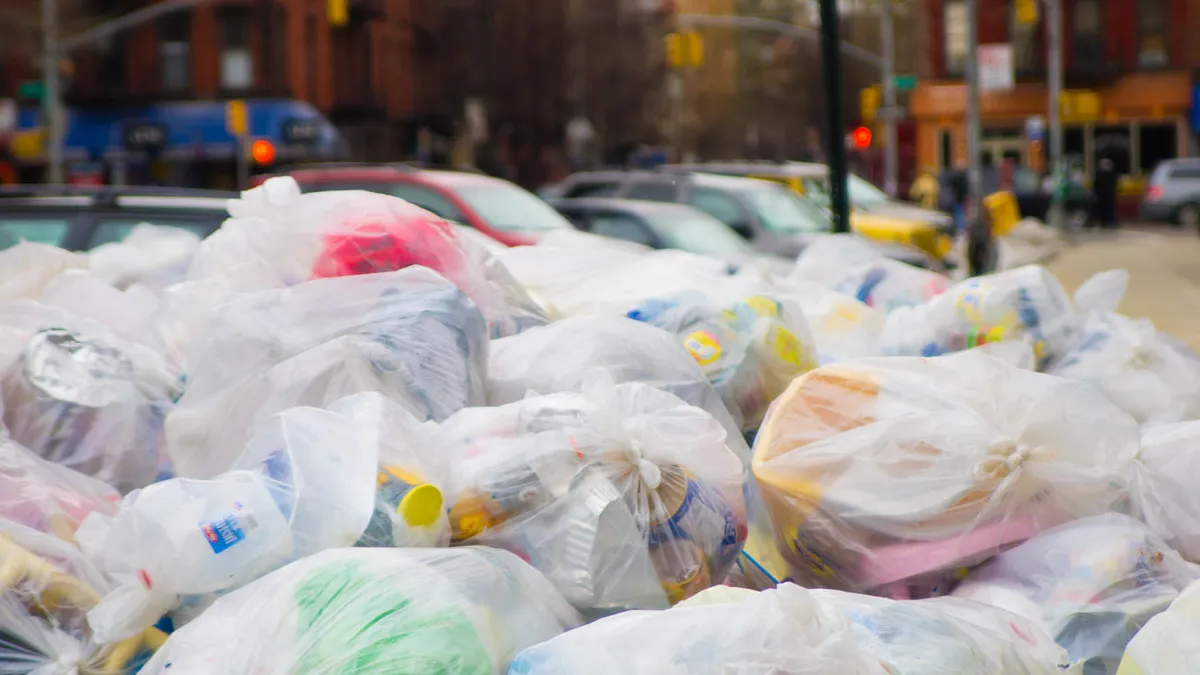Innovations in packaging are outpacing the plastics recycling industry’s ability to properly collect and sort materials, but opinions about how to respond varied widely among panelists at the Society of Environmental Journalists’ annual conference in Fort Collins, Colorado.
“The biggest issue is not (that) recycling doesn’t work,” said Steve Alexander, president and chief executive officer of the Association of Plastics Recyclers (APR). “The biggest issue is that our collection infrastructure is based on 1970s and 1980s technology. Our infrastructure is woefully lacking and woefully behind the packaging stream that we have today. Plastic recyclers operate at about 60% capacity today. We can recycle a lot more material. We can’t get it. We can recycle anything if it’s collected and sorted properly.”
Alexander noted how increasingly ambitious sustainability goals from companies and legislators are presenting a challenge in terms of available supply. The initial draft of recent California legislation, for example, mandated 75% recycled content in plastic beverage containers by 2030. Gov. Gavin Newsom vetoed the final version of that legislation over the weekend, which called for 50% by 2030.
“Our studies show that you can ask for that, but it’s not based in reality because you’re only collecting enough material for us to process to provide you with 25% content by 2030,” said Alexander. “We need to collect more material.”
Eugene Chen, chair of the chemistry department of Colorado State University, called chemical recycling his “favorite solution” to the industry’s difficulties. He said there are polymers that can make chemical recycling work, but noted that energy input is a challenge.
“I think there’s a great deal of confusion about chemical recycling – inabilities or inefficiencies or why it doesn’t take off,” said Chen. “The problem is they do the chemical recycling based on polymers not designed for recyclability. They are legacy polymers, high performers, very, very stable polymers that are very difficult to do chemical recycling."
“I think the attitudes of the industry, especially those legacy polymer producers, that the new polymers entering the market will contaminate their products, I think that’s an incorrect attitude,” he added. “They should welcome the design of new polymers that has an advantage in chemical recyclability, biodegradability performance. I think there should be a multi-pronged approach, not just a single approach.”
Arguments are often made that effective chemical recycling is decades away, but Chen said a scalable chemical recycling process could be achieved sooner if the industry was willing to invest in the solution.
An April report from Closed Loop Partners' Center for the Circular Economy estimated there could be $120 billion worth of revenue potential for chemical recycling in North America. Multiple projects are already operational or underway. Still, APR believes chemical recycling should be part of the solution rather than an attempt at replacing mechanical recycling.
“The exuberance over chemical recycling borders on irrationality,” Alexander said. “By that I mean, the focus and the attention that that’s the new big thing, I got news for you, I have three recyclers out there that have been doing chemical recycling and putting out sustainable products for 30 years. It’s not new. It’s not the silver bullet per se, but it is …. part of the solution. We need to commercialize it. We need to broaden it.”
Chemical recycling has received even more attention from plastics producers and philanthropic organizations as a potential solution to the mounting concerns around marine pollution. "Enormous" public interest in the issue has made for a “real explosion” of state and local bills, according to Beyond Plastics Founder Judith Enck, but one federal package getting recent attention in Congress has proven controversial. Save Our Seas 2.0 has support from the plastics industry in part because of its potential to expand chemical recycling opportunities.
“The nicest thing I can say about it is that it’s completely inadequate,” said Enck, a former regional administrator for the Environmental Protection Agency.
Enck feels the legislation's "Genius Prize” that would be awarded for innovations with the potential to reduce plastic waste and prevent marine debris under the new bill is “great,” but said it also has a “very troubling provision” for a marine debris coordinating committee that would submit a report on innovative uses for plastic waste to Congress. In Enck's view, this misses the broader possibilities of reducing plastic generation rather than just managing it.
“For decades we’ve focused on end of life,” she said. “I really want to invite us to come back to the beginning. I think the problem with plastics is we’re making too much plastic.”
APR and other plastics groups feel this is only part of the conversation.
“From our perspective, regardless of whether or not we reduce plastics production at the virgin level, plastics are gonna be around so we have to deal with them,” Alexander said. “What we have to do is we have to create an incentive when the consumer makes a disposal decision that they make the right decision. We can’t abandon the recyclability of the material because there’s still plastics that are gonna be manufactured.”






















